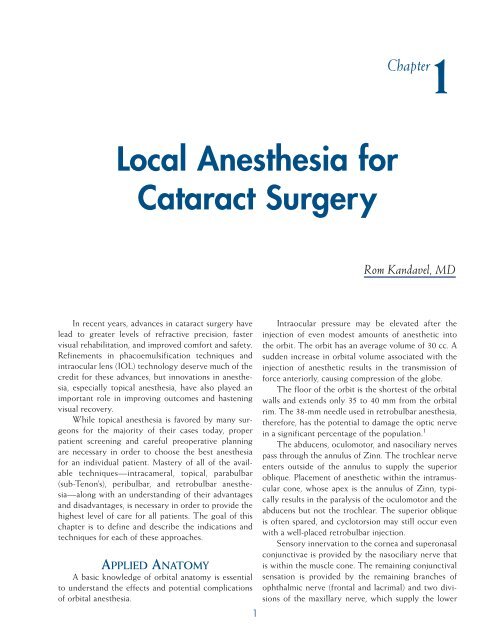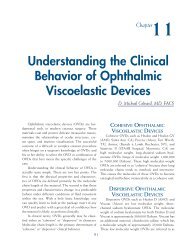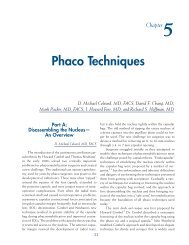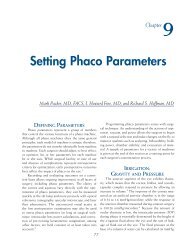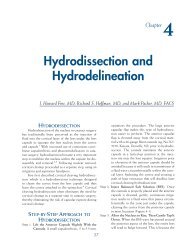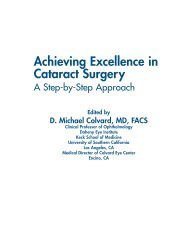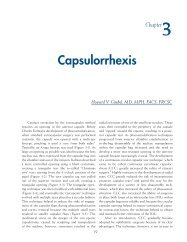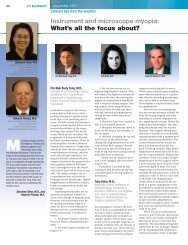Local Anesthesia for Cataract Surgery
Local Anesthesia for Cataract Surgery
Local Anesthesia for Cataract Surgery
Create successful ePaper yourself
Turn your PDF publications into a flip-book with our unique Google optimized e-Paper software.
Chapter<br />
1<br />
<strong>Local</strong> <strong>Anesthesia</strong> <strong>for</strong><br />
<strong>Cataract</strong> <strong>Surgery</strong><br />
Rom Kandavel, MD<br />
In recent years, advances in cataract surgery have<br />
lead to greater levels of refractive precision, faster<br />
visual rehabilitation, and improved com<strong>for</strong>t and safety.<br />
Refinements in phacoemulsification techniques and<br />
intraocular lens (IOL) technology deserve much of the<br />
credit <strong>for</strong> these advances, but innovations in anesthesia,<br />
especially topical anesthesia, have also played an<br />
important role in improving outcomes and hastening<br />
visual recovery.<br />
While topical anesthesia is favored by many surgeons<br />
<strong>for</strong> the majority of their cases today, proper<br />
patient screening and careful preoperative planning<br />
are necessary in order to choose the best anesthesia<br />
<strong>for</strong> an individual patient. Mastery of all of the available<br />
techniques—intracameral, topical, parabulbar<br />
(sub-Tenon’s), peribulbar, and retrobulbar anesthesia—along<br />
with an understanding of their advantages<br />
and disadvantages, is necessary in order to provide the<br />
highest level of care <strong>for</strong> all patients. The goal of this<br />
chapter is to define and describe the indications and<br />
techniques <strong>for</strong> each of these approaches.<br />
Applied Anatomy<br />
A basic knowledge of orbital anatomy is essential<br />
to understand the effects and potential complications<br />
of orbital anesthesia.<br />
<br />
Intraocular pressure may be elevated after the<br />
injection of even modest amounts of anesthetic into<br />
the orbit. The orbit has an average volume of 30 cc. A<br />
sudden increase in orbital volume associated with the<br />
injection of anesthetic results in the transmission of<br />
<strong>for</strong>ce anteriorly, causing compression of the globe.<br />
The floor of the orbit is the shortest of the orbital<br />
walls and extends only 35 to 40 mm from the orbital<br />
rim. The 38-mm needle used in retrobulbar anesthesia,<br />
there<strong>for</strong>e, has the potential to damage the optic nerve<br />
in a significant percentage of the population. 1<br />
The abducens, oculomotor, and nasociliary nerves<br />
pass through the annulus of Zinn. The trochlear nerve<br />
enters outside of the annulus to supply the superior<br />
oblique. Placement of anesthetic within the intramuscular<br />
cone, whose apex is the annulus of Zinn, typically<br />
results in the paralysis of the oculomotor and the<br />
abducens but not the trochlear. The superior oblique<br />
is often spared, and cyclotorsion may still occur even<br />
with a well-placed retrobulbar injection.<br />
Sensory innervation to the cornea and superonasal<br />
conjunctivae is provided by the nasociliary nerve that<br />
is within the muscle cone. The remaining conjunctival<br />
sensation is provided by the remaining branches of<br />
ophthalmic nerve (frontal and lacrimal) and two divisions<br />
of the maxillary nerve, which supply the lower
Chapter 1<br />
Table 1-1<br />
Contraindications to <strong>Local</strong> <strong>Anesthesia</strong><br />
Relative<br />
Tremor<br />
Anxiety<br />
Claustrophobia<br />
Children<br />
Poor communication/language barrier/deafness<br />
Long operative time<br />
Absolute<br />
Inability to cooperate (eg, schizophrenia, dementia)<br />
Uncontrolled coughing/movement disorder<br />
Table 1-2<br />
Contraindications to Topical <strong>Anesthesia</strong><br />
Relative<br />
Photophobia<br />
Anxiety<br />
Deafness<br />
Long operative time<br />
Absolute<br />
Poor communication/language barrier/deafness<br />
Cannot follow directions<br />
Insufficient pain control (as in prior eye surgery)<br />
lid and conjunctiva (enters via the inferior orbital <strong>for</strong>amen).<br />
All of these additional somatosensory nerves lie<br />
outside of the muscular cone. For this reason, a retrobulbar<br />
block can still leave areas of the conjunctiva<br />
sensitive to pain and touch.<br />
The dura surrounding the optic nerve is continuous<br />
with the dura of the brain. Inadvertent injection<br />
of anesthetic into the subdural space within the nerve,<br />
there<strong>for</strong>e, can result in brainstem anesthesia.<br />
Preoperative Evaluation<br />
Careful patient screening is essential in order to<br />
determine which <strong>for</strong>m of anesthesia is best suited <strong>for</strong><br />
an individual. A surgeon should develop a checklist<br />
to avoid missing data that can influence the choice of<br />
anesthesia. A history and physical examination, with<br />
review of medications, is an excellent starting point<br />
<strong>for</strong> evaluation. Particular attention should be given to<br />
the patient’s ability to communicate, lie flat and still,<br />
and follow directions. A history of congestive heart<br />
failure, chronic obstructive pulmonary disease, chronic<br />
bronchitis, claustrophobia, anticoagulation status, and<br />
use of alpha-blockers (tamsulosin) should be addressed<br />
with each patient.<br />
Retrobulbar and peribulbar anesthesia generally<br />
provide excellent intraoperative pain control with<br />
the added benefit of complete or partial akinesia and<br />
visual block. General anesthesia may be utilized when<br />
generalized muscle paralysis is an additional factor to<br />
ensure surgical success. Topical anesthesia should be<br />
reserved <strong>for</strong> communicative and calm patients who<br />
have no relevant comorbidities. The surgeon should<br />
be experienced and expecting a shorter surgery without<br />
anticipated complications or added procedures.<br />
Longer procedures that may require iris manipulation<br />
or scleral suturing may benefit from retrobulbar or<br />
peribulbar anesthesia <strong>for</strong> improved iris and ciliary body<br />
anesthesia. While most patients can lie still, some may<br />
not be able to follow directions and are not well suited<br />
<strong>for</strong> topical anesthesia. Patients who have psychiatric<br />
disease or other comorbidities that prevent them from<br />
lying still may be candidates <strong>for</strong> general anesthesia.<br />
The in<strong>for</strong>mation contained in Tables 1-1 and 1-2<br />
can serve as general guidelines <strong>for</strong> anesthesia selection.<br />
In some instances, reviewing the procedure and<br />
different anesthesia approaches with the patient is<br />
useful. This allows the patient to self-assess his or her<br />
preferences. The discussion also allows the patient to<br />
ask questions and develop greater com<strong>for</strong>t with the<br />
surgeon and surgery.<br />
Retrobulbar <strong>Anesthesia</strong><br />
Multiple protocols have been published with a<br />
common goal of improving the efficacy and safety of<br />
retrobulbar anesthesia. Complications arising from retrobulbar<br />
anesthesia include retrobulbar hemorrhage,<br />
globe/nerve per<strong>for</strong>ation, extraocular muscle injury,<br />
and brainstem anesthesia/death. 2 Other disadvantages<br />
include the need <strong>for</strong> increased sedation, a postoperative<br />
eye patch, longer visual recovery, ptosis, chemosis,<br />
subconjunctival hemorrhage, and increased posterior<br />
pressure during surgery. The most feared complication
<strong>Local</strong> <strong>Anesthesia</strong> <strong>for</strong> <strong>Cataract</strong> <strong>Surgery</strong> <br />
of retrobulbar injection, per<strong>for</strong>ation of the globe, is<br />
more common with eyes of higher axial length and/or<br />
staphyloma. 2<br />
A well-placed retrobulbar block usually results in<br />
excellent akinesia and sensory block with some visual<br />
block also. As previously noted, motor nerves within<br />
the muscle cone, the abducens, oculomotor, as well as<br />
the sensory nasociliary nerve, are affected, but because<br />
the trochlear nerve passes outside the cone, superior<br />
oblique muscle innervation is usually spared and cyclotorsion<br />
may still occur. Most surgeons supplement<br />
retrobulbar blocks with topical anesthesia to complete<br />
anterior segment anesthesia because portions of the<br />
trigeminal, which supply the conjunctiva and lid, also<br />
pass outside the muscle cone.<br />
The goal of retrobulbar anesthesia is the placement<br />
of anesthetic into the intramuscular cone located<br />
behind the globe and anterior to the orbital apex.<br />
Structures traversed by the retrobulbar needle include<br />
the skin, orbital septum, periocular tissue/fat, and<br />
the intramuscular connective tissue. Structures to be<br />
avoided include blood vessels, extraocular muscles,<br />
the globe, and the optic nerve. The technique detailed<br />
below is designed to avoid these structures and give<br />
reliable and reproducible anesthesia. Each surgeon will<br />
develop personal amendments, but the basic tenets<br />
apply.<br />
Injectable mixtures should include a total volume<br />
of 10 cc or less composed of 2% lidocaine without<br />
epinephrine mixed 50:50 with 0.75%. Note that this<br />
50:50 mixture dilutes each component to half the<br />
original concentration. Some surgeons may prefer 4%<br />
lidocaine, if available, to yield a final effective concentration<br />
of 2% lidocaine. The addition of bupivacaine<br />
increases the duration of action. If hyaluronidase is<br />
available, it can also be added to the mixture to speed<br />
diffusion of the medication and improve akinesia and<br />
sensory block. Hyaluronidase can also decrease posterior<br />
pressure by causing the volume to distribute more<br />
quickly. Fifteen to 20 units of hyaluronidase per mL of<br />
solution can be used.<br />
A 38-mm (1.5-inch) 23-gauge needle with a rounded<br />
point (Atkinson) is preferred. A standard sharp<br />
point needle has the advantage of passing through tissues<br />
more easily with less discom<strong>for</strong>t, but the reduced<br />
sensory feedback during injection and higher potential<br />
<strong>for</strong> injury to ocular structures favors the Atkinson or<br />
blunt-tipped needle. 3 A 10-cc syringe is also preferred<br />
over a 5-cc <strong>for</strong> better tactile control of injection pressure<br />
and enough volume to change needles and continue<br />
with facial nerve blocks after retrobulbar injection<br />
using the same syringe.<br />
Retrobulbar anesthesia is per<strong>for</strong>med prior to sterile<br />
prep. The patient is positioned flat on the operative<br />
bed. At the level of the <strong>for</strong>ehead, 1-inch silk, plastic,<br />
or paper tape can be used to secure the head to the<br />
table if an assistant is not available. Intravenous propofol<br />
or Versed (Hospira, Lake Forest, IL) should be<br />
administered in conjunction with an analgesic, such<br />
as fentanyl, to help prepare the patient <strong>for</strong> injection.<br />
If propofol is used, time <strong>for</strong> the medication to take<br />
effect should be allowed. Testing the lack of orbicularis<br />
contraction by gently brushing the eyelashes can help<br />
verify adequate sedation.<br />
Following surgery, the eye should be patched. This<br />
is because the retrobulbar block reduces sensation<br />
of the eye (which results in a reduced blink reflex),<br />
provides akinesia (which causes a transient diplopia),<br />
and reduces vision (which is frightening to the<br />
patient). The patch may be removed after 4 to 6 hours<br />
in patients who have received only lidocaine. When<br />
bupivacaine is used, the patch should remain <strong>for</strong> not<br />
less than 8 hours.<br />
Parabulbar (Sub-Tenon’s)<br />
<strong>Anesthesia</strong><br />
Some surgeons have adopted the technique of<br />
using a blunt-tipped cannula intraoperatively to inject<br />
the same anesthetic mixture. This is known as a parabulbar<br />
block. Parabulbar blocks can be placed as a<br />
planned anesthesia or can be utilized intraoperatively<br />
if the patient is uncooperative or has inadequate pain<br />
control with topical/peribulbar anesthesia.<br />
This technique avoids the hazards of a sharp<br />
needle placement into this space and is a safer alternative<br />
to retrobulbar anesthesia, but it can also result in<br />
increased chemosis, subconjuctival hemorrhage, and<br />
incomplete anesthesia if the cannula is not advanced in<br />
the sub-Tenon’s space. 4 Damage to the vortex veins has<br />
also been reported. 5 Onset is rapid, but the added dissection<br />
can add to operative time. The disadvantages<br />
such as the need <strong>for</strong> patching with delayed visual rehabilitation<br />
apply, as with retrobulbar anesthesia.<br />
Peribulbar <strong>Anesthesia</strong><br />
The injection of anesthesia within the orbit without<br />
directing the needle inside the muscle cone<br />
reduces the risk of damage to vital structures. The soft<br />
tissue, intramuscular septae are incomplete and allow<br />
<strong>for</strong> the diffusion of medication into the cone, resulting<br />
in akinesia and visual block, as well as sensory deinnervation<br />
to the nasociliary and extraconal divisions
Chapter 1<br />
of first and second divisions of the trigeminal nerve.<br />
This technique relies on larger volumes (7 to 10 cc)<br />
and works best if supplemented by 500 units of hyaluronidase.<br />
Sedation with propofol, as with retrobulbar<br />
anesthesia, is preferred.<br />
Sensory block and akinesia are dependent on diffusion,<br />
there<strong>for</strong>e this technique requires reassessment<br />
of akinesia (if desired) after 5 to 7 minutes. If adequate<br />
medial rectus akinesia is not obtained, the peribulbar<br />
injection can be repeated using the same technique<br />
targeting the medial fat compartment. Up to 24%<br />
of patients will require this supplemental 3- to 5-cc<br />
block. 6 The entrance site <strong>for</strong> the supplemental block is<br />
just nasal to the medial rectus, adjacent to the caruncle,<br />
and parallel to the medial orbital wall in the same<br />
fashion as described above. Higher volumes overall<br />
are used, there<strong>for</strong>e orbital pressure is increased and<br />
ecchymosis and chemosis are more likely than with the<br />
retrobulbar block. 7 Reports of retrobulbar hemorrhage<br />
and globe per<strong>for</strong>ation have also been published but are<br />
less common. This technique has reported anesthetic<br />
pain control similar to retrobulbar placement, but has<br />
an improved safety profile. 8 Overall, the advantages<br />
of peribulbar anesthesia should be weighed against the<br />
frequent need <strong>for</strong> supplemental anesthesia, incomplete<br />
akinesia, the larger volume of anesthesia, and longer<br />
time required <strong>for</strong> complete diffusion.<br />
Topical and Intracameral<br />
<strong>Anesthesia</strong><br />
As phacoemulsification techniques have advanced,<br />
incision size has decreased, the need <strong>for</strong> iris manipulation<br />
has diminished, and operative time has lessened.<br />
These changes have resulted in a decrease in the need<br />
<strong>for</strong> complete akinesia, long duration of ocular anesthesia,<br />
and intensity of iris and ciliary body sensory block.<br />
Topical and intracameral anesthesia alone can provide<br />
adequate anterior segment anesthesia <strong>for</strong> noncomplex<br />
phacoemulsification with proper patient selection. 9<br />
Use in trabeculectomy, secondary sutured IOLs, and<br />
pterygium excision has also become more common.<br />
Topical anesthesia avoids the systemic and ocular<br />
risks of the previously described modalities. In addition,<br />
it allows <strong>for</strong> quick visual recovery. Monitored<br />
anesthesia care can be used, but surgery can also<br />
be per<strong>for</strong>med without intravenous agents (discussed<br />
below). It should be noted that many surgeons who<br />
use retrobulbar or peribulbar block use topical and/or<br />
intracameral anesthetic in addition to help complete<br />
the anterior segment sensory block. Communicative,<br />
calm, cooperative patients are candidates <strong>for</strong> topical<br />
anesthesia. Careful patient selection is important.<br />
Multiple agents are available <strong>for</strong> topical anesthesia<br />
and include tetracaine 0.5% drops, Tetravisc 0.5%<br />
gel (Ocusoft, Richmond, TX), lidocaine 2% jelly,<br />
Xylocaine 4% (AstraZeneca, Wilmington, DE), and<br />
bupivacaine 0.75%. Topical agents are placed at least 5<br />
to 10 minutes prior to surgery. They provide excellent<br />
intraoperative pain control and also allow the patient<br />
to have less discom<strong>for</strong>t from the Betadine prep prior<br />
to draping.<br />
Drop preparations are generally administered<br />
in two to three repeated doses separated by 5 to 10<br />
minutes. Gel preparations have the benefit of coating<br />
the eye without requiring repeated doses. If used prior<br />
to dilating agents, gels can interfere with absorption.<br />
There<strong>for</strong>e, many surgeons place a liquid preparation<br />
such as proparacaine 0.5% or tetracaine drops first<br />
and then complete the dilation protocols. After the<br />
pupil is dilated and 5 to 10 minutes prior to entering<br />
the operating room, Tetravisc or lidocaine gel can be<br />
placed into the eye. Lidocaine gel can be more viscous<br />
and at times more difficult to place under the lids to<br />
anesthetize the superior and inferior conjunctiva and<br />
<strong>for</strong>nices. 10 Tetravisc has an intermediate viscosity and<br />
there<strong>for</strong>e spreads like a liquid drop but also coats like<br />
a gel. Each surgeon should develop a simple, reproducible<br />
protocol <strong>for</strong> topical anesthesia that can be<br />
per<strong>for</strong>med efficiently by the surgical staff. One other<br />
variant on this <strong>for</strong>m of anesthesia includes soaking<br />
a sponge with both dilating and/or anesthetic drops<br />
(perilimbal anesthesia) and placing it in the inferior<br />
<strong>for</strong>nix <strong>for</strong> 10 to 15 minutes. Anecdotal reports suggest<br />
that soaked pledgets can deliver higher concentrations<br />
of both anesthetic and mydriatic medications, but the<br />
actual procedure of sponge placement can be more<br />
intrusive than drops alone.<br />
Topical anesthesia alone may not provide adequate<br />
iris and ciliary body anesthesia. There<strong>for</strong>e, many<br />
surgeons will supplement with intracameral 1% nonpreserved<br />
lidocaine. After the initial paracentesis is<br />
created, approximately 0.5-cc nonpreserved lidocaine<br />
is instilled into the anterior chamber. Uncomplicated<br />
cataract surgery can be per<strong>for</strong>med with topical anesthesia<br />
alone, but prospective trials suggest an additional<br />
anesthetic benefit to intracameral lidocaine. 11 This<br />
additional agent represents a very quick, extra step<br />
in cataract surgery. At 1% concentration, endothelial<br />
cell toxicity has not been demonstrated in humans.
<strong>Local</strong> <strong>Anesthesia</strong> <strong>for</strong> <strong>Cataract</strong> <strong>Surgery</strong> <br />
The additional anesthetic effect makes any iris touch<br />
or manipulation more com<strong>for</strong>table. If a scleral sutured<br />
posterior chamber lens, pupil expansion device, or iris<br />
stretching is necessary, intracameral anesthesia can be<br />
a useful adjunct. Other agents such as epinephrine or<br />
phenylephrine can also be added to this intracameral<br />
solution. These and other techniques are discussed in<br />
other portions of this text.<br />
Facial Nerve Blocks<br />
Occasionally, a patient may have difficulty with<br />
relaxing his or her orbicularis oculi muscle. Many<br />
times this is anxiety related, other times it may be<br />
an idiosyncratic reflex specific to that individual.<br />
Psychiatric disease can be a risk factor. If intravenous<br />
agents fail to reduce squeezing, facial nerve blocks<br />
in combination with any of the anesthetic modalities<br />
above can allow the surgeon to have improved control.<br />
Generally, patients who require facial nerve blocks are<br />
good candidates <strong>for</strong> retrobulbar/peribulbar anesthesia<br />
because of associated Bell’s phenomenon. Facial nerve<br />
blocks can be per<strong>for</strong>med at any portion of the extracranial<br />
course after it exits the stylomastoid <strong>for</strong>amen.<br />
The nerve gives off multiple branches as it courses<br />
from behind the ear over the angle of the mandible,<br />
penetrating the parotid gland and dividing into its terminal<br />
branches, including the temporal and zygomatic,<br />
which supply the orbicularis. Types of facial nerve<br />
blocks are differentiated by their location, and each<br />
has inherent advantages and disadvantages.<br />
Careful placement of additional anesthetic in the<br />
inferior <strong>for</strong>nix and anterior lateral orbit as the needle<br />
is withdrawn during retrobulbar and peribulbar anesthesia<br />
can also result in seventh nerve block in up to<br />
88% of cases by continued diffusion. 12 Although less<br />
reliable, this can obviate the need <strong>for</strong> a separate facial<br />
nerve block.<br />
The Nadbath block is directed at the exit of the<br />
nerve at the stylomastoid <strong>for</strong>amen. Respiratory and<br />
vocal chord paralysis have been reported with inadvertent<br />
injection into the jugular <strong>for</strong>amen. 13-15 Prolonged<br />
facial nerve block has also been reported. 15 This technique<br />
avoids ecchymosis of the face and is less painful,<br />
but also can temporarily paralyze multiple divisions of<br />
the facial nerve.<br />
The O’Brien is placed more distally just below the<br />
zygomatic arch, anterior to the tragus. This site can<br />
be more painful and can also cause paralysis of the lips<br />
and lower face in addition to the intended superior<br />
divisions.<br />
The modified Van Lint targets the terminal branches<br />
at the lateral canthus and lid. This technique avoids<br />
the paralysis of the other divisions of the seventh nerve<br />
but can cause lid ecchymosis and edema.<br />
Facial nerve blocks are best done with conscious<br />
sedation usually directly after retrobulbar or peribulbar<br />
block while the propofol is still at maximal effect.<br />
The same 10-cc syringe can be used if appropriate<br />
by changing the needle to a conventional sharp point<br />
1-inch 30-gauge or 27-gauge needle.<br />
Conscious Sedation and<br />
General Anesthetic Agents<br />
<strong>Cataract</strong> surgeons should possess a basic understanding<br />
of common anesthetic agents. Many times<br />
feedback from the patient is only perceived and<br />
communicated to the surgeon intraoperatively. The<br />
surgeon may also better understand the needs of each<br />
patient, having treated him or her <strong>for</strong> many years,<br />
than the anesthesiologist present <strong>for</strong> the surgery. An<br />
understanding of the common medications and their<br />
relative analgesic, anxiolytic, and amnestic properties<br />
will allow the surgeon to help tailor preoperative planning<br />
and intraoperative supplementation.<br />
Monitored anesthesia care involves intravenous<br />
sedation and analgesia with noninvasive monitoring.<br />
This allows <strong>for</strong> less physical stress on the patient. The<br />
patient is able to respond to commands, facilitating<br />
surgery, and recovery is quicker. Conversion to general<br />
anesthesia is still possible. Commonly used single<br />
agents include opiates (fentanyl), benzodiazepines<br />
(midazolam), and propofol.<br />
Propofol (Diprivan [AstraZeneca]) is a short-acting<br />
induction agent that provides temporary sedation<br />
without analgesia. Propofol can be used prior to retrobulbar<br />
block placement. Although the block can be<br />
placed without propofol, this agent provides a short<br />
duration of deep sedation with amnesia. Testing lack<br />
of orbicularis contraction by gentle eyelash stimulation<br />
can be a helpful measure of adequate sedation prior to<br />
retrobulbar placement. Hypotension and temporary<br />
apnea are possible, there<strong>for</strong>e pulsoximetry and blood<br />
pressure monitoring are essential.<br />
Fentanyl and midazolam (Versed) can be used<br />
alone or in conjunction. Fentanyl, a short-acting narcotic,<br />
provides analgesia with some mild anxiolysis.<br />
Midazolam is an excellent anxiolytic and can also have<br />
an amnestic effect. Midazolam is short acting, water<br />
soluble, and has no analgesic properties. Both have<br />
a quick onset of action and can be augmented dur-
Chapter 1<br />
Figure 1-1. Proper patient stabilization and position<br />
<strong>for</strong> retrobulbar/peribulbar anesthesia.<br />
ing surgery <strong>for</strong> added effect. Midazolam can have a<br />
disinhibiting effect that can result in a lack of patient<br />
cooperation. This disinhibition and confusion is more<br />
common in the elderly and quite rare in younger<br />
patients. In some circumstances, patients can attempt<br />
to sit up or remove their draping. There<strong>for</strong>e, careful<br />
attention and communication with the patient and<br />
anesthesiologist during surgery should be maintained<br />
in order to continually assess patient com<strong>for</strong>t and<br />
mental status.<br />
Cooperation with adequate pain and anxiety control<br />
is the goal of every cataract surgery. The surgeon’s<br />
demeanor and communication can help supplement<br />
pharmacologic anesthesia. Some individuals may experience<br />
pain but not alert the surgeon <strong>for</strong> fear of “interfering”<br />
with the surgery. It can be useful to briefly<br />
describe to the patient what to expect in the operating<br />
room and encourage him or her to verbally express<br />
discom<strong>for</strong>t so that added analgesia can be provided.<br />
Step-by-Step Approach to<br />
Retrobulbar <strong>Anesthesia</strong><br />
Step 1. Anesthetic Preparation. A 38-mm (1.5-inch)<br />
23-gauge needle with a rounded point (Atkinson)<br />
on a 10-cc syringe is preferred. Ten cc<br />
containing 2% lidocaine without epinephrine<br />
mixed 50:50 with 0.75% bupivacaine and 10 to<br />
15 units hyaluronidase per cc (optional) can be<br />
used.<br />
Step 2. Patient Position. The assistant should be present<br />
at the head of the bed, facing the feet, holding<br />
the head securely with both hands. One<br />
finger can be used to lift the upper lid of the<br />
operative eye to allow the surgeon to visualize<br />
Figure 1-2. The retrobulbar/peribulbar needle<br />
should enter at the lateral one-third of the lower<br />
eyelid below the globe with the eye in primary<br />
position. Supplemental medial peribulbar blocks<br />
enter between the caruncle and medial rectus.<br />
the globe throughout the procedure (Figure<br />
1-1). The surgeon should be on the same side of<br />
the bed as the operative eye. The lower eye lid<br />
skin should be cleaned with an alcohol swab.<br />
Step 3. Needle Placement. The needle tip, bevel<br />
down, is advanced parallel to the orbital floor,<br />
entering at the lateral third of the inferior lid.<br />
The patient’s eye should be in primary position<br />
(Figures 1-2 and 1-3).<br />
Step 4. Needle Advancement. The surgeon’s index<br />
finger can be used to palpate and displace the<br />
globe superiorly as the needle is positioned<br />
to create adequate space <strong>for</strong> the needle to<br />
pass inferior to the globe between the lateral<br />
and inferior rectus muscles. Resistance to the<br />
rounded needle can be noted when the orbital<br />
septum is reached. Once the needle has passed<br />
the equator of the globe (the halfway point of<br />
the needle should be at the level of the iris),<br />
the needle is then angled superior and slightly<br />
medial toward the muscular cone to a location<br />
posterior to the macula. A small amount<br />
of anesthesia can be injected as the needle is<br />
advanced.<br />
Step 5. Entering the Muscle Cone and Injecting. Resistance<br />
and relief can be detected as the needle<br />
enters the muscle cone. The syringe plunger<br />
should be gently withdrawn to ensure a blood<br />
vessel has not been entered prior to injection.<br />
Depending on anticipated cone volume, 2.5 to<br />
4.0 cc should be injected. An additional 1 to 2<br />
cc can be injected as the needle is withdrawn.
<strong>Local</strong> <strong>Anesthesia</strong> <strong>for</strong> <strong>Cataract</strong> <strong>Surgery</strong> <br />
Figure 1-3. The retrobulbar anesthesia needle is<br />
directed toward a point posterior to the macula<br />
after being advanced past the equator of the<br />
globe. (Medical illustration copyright © 2008<br />
Nucleus Medical Art. All rights reserved. www.<br />
nucleusinc.com.)<br />
Step 6. Assessment. Gentle “on and off” digital pressure<br />
should be used <strong>for</strong> 2 to 4 minutes to help<br />
facilitate diffusion of the anesthesia. Checking<br />
<strong>for</strong> the amount of akinesia can help assess the<br />
success of the retrobulbar block within a few<br />
minutes of placement.<br />
If progressive proptosis, hemorrhagic chemosis,<br />
or unexplained posterior pressure during<br />
surgery is detected, retrobulbar hemorrhage<br />
should be suspected. Immediate lateral canthotomy<br />
and cantholysis is the treatment of<br />
choice. Some surgeons proceed with surgery<br />
immediately once retrobulbar pressure is reduced.<br />
Most surgeons prefer to delay the procedure<br />
and wait a sufficient time <strong>for</strong> recovery<br />
and reassessment.<br />
Step-by-Step Approach to<br />
Peribulbar <strong>Anesthesia</strong><br />
Step 1. Anesthetic Preparation. A 25-mm 23-gauge<br />
needle with a rounded point (Atkinson) on<br />
a 20-cc syringe is preferred. Ten cc containing<br />
2% lidocaine (without epinephrine) mixed<br />
50:50 with 0.75% bupivacaine and 10 to 15<br />
units hyaluronidase per cc is used.<br />
Step 2. Patient Position. The assistant should be present<br />
at the head of the bed, facing the feet,<br />
holding the head securely with both hands.<br />
One finger can be used to lift the upper lid of<br />
the operative eye to allow the surgeon to visualize<br />
the globe throughout the procedure. The<br />
surgeon should be on the same side of the bed<br />
as the operative eye. The lower eye lid skin<br />
should be cleaned with an alcohol swab.<br />
Step 3. Needle Entry and Injection. The entry point<br />
is at the outer third of the lower eyelid where<br />
the floor meets the lateral wall. The needle is<br />
advanced, bevel down, parallel to the floor until<br />
the needle base is at the level of the iris. Aspiration<br />
first and then 7 to 10 cc of anesthetic<br />
solution is injected.<br />
Step 4. Supplemental Block. Supplemental block if<br />
incomplete anesthesia is placed in the same<br />
fashion medial to the medial rectus adjacent to<br />
the caruncle. The needle is advanced parallel<br />
to the medial wall and 3 to 5 cc of the same<br />
mixture is injected.<br />
Step-by-Step Approach to<br />
Parabulbar (Sub-Tenon’s)<br />
<strong>Anesthesia</strong><br />
Step 1. Conjunctival Incision. An incision is made<br />
with a Wescott scissors between the superior<br />
rectus and lateral rectus 9 to 10 mm posterior<br />
to the limbus down to bare sclera. The scissors<br />
are used to bluntly dissect posteriorly to allow<br />
space to advance the cannula (Figure 1-4).<br />
Step 2. Anesthetic Placement. A 5-cc syringe with a<br />
blunt-tipped cannula containing a 50:50 lidocaine<br />
2% (without epinephrine) and bupivacaine<br />
0.75% mixture is advanced around the<br />
equator of the globe into the anterior intraconal<br />
space. It is important to directly visualize<br />
the blunt cannula entering under Tenon’s<br />
capsule (Figure 1-5). The cannula should follow<br />
the curve of the globe posteriorly. Two to<br />
3 cc should be injected.<br />
Step-by-Step Approach to<br />
Topical and Intracameral<br />
<strong>Anesthesia</strong><br />
Application of Topical Anesthetic<br />
Tetracaine or proparacaine is used in two to<br />
three divided doses in each eye prior to surgery.<br />
The first dose is given just prior to dilating<br />
agents and then repeated every 5 to<br />
10 minutes with each application of dilating
Chapter 1<br />
Figure 1-4. Dissection to bare sclera in the superotemporal<br />
quadrant. (Photo courtesy of Thomas A.<br />
Oetting, MS, MD.)<br />
Figure 1-5. The cannula is advanced in sub-Tenon’s<br />
space posteriorly hugging the globe. (Photo courtesy<br />
of Thomas A. Oetting, MS, MD.)<br />
drops. One additional application just prior to<br />
surgery may be necessary. If Tetravisc is utilized,<br />
one dose 5 to 10 minutes prior to surgery<br />
is placed in each eye.<br />
Intracameral <strong>Anesthesia</strong><br />
Sterile, intracameral 1% nonpreserved lidocaine<br />
in a 1-cc syringe with a blunt cannula is<br />
prepared. After the initial paracentesis is created,<br />
approximately 0.5-cc nonpreserved lidocaine<br />
is instilled into the anterior chamber.<br />
Viscoelastic should be instilled into the anterior<br />
chamber after at least 5 seconds to allow<br />
anesthetic effect.<br />
Step-by-Step Approach to<br />
Facial Nerve Blocks<br />
A 27-gauge or 30-gauge 1-inch needle on a<br />
5-cc syringe is preferred. Two percent lidocaine with<br />
epinephrine is mixed 50:50 with 0.75% bupivacaine <strong>for</strong><br />
facial nerve blocks (Figure 1-6).<br />
Nadbath<br />
Step 1. Palpate the Location of the Stylomastoid Foramen.<br />
Use an alcohol swab to clean the area.<br />
The needle is entered perpendicular to the skin<br />
2 mm anterior to the anterior-superior margin<br />
of the mastoid process behind the ear.<br />
Step 2. Anesthetic Application. Two to 3 cc of 2% lidocaine<br />
alone or mixed 50:50 with 0.75% bupivacaine<br />
is injected. This technique avoids ecchymosis<br />
of the face and is less painful but also<br />
can temporarily paralyze multiple divisions of<br />
the facial nerve.<br />
O’Brien<br />
Step 1. Palpate the Zygomatic Process Anterior to<br />
the Tragus. Use an alcohol swab to clean the<br />
area. This method involves blocking the nerve<br />
above the condyloid process anterior to the<br />
tragus just below the zygomatic process.<br />
Step 2. Anesthetic Application. Inject a volume of 1<br />
to 2 cc. This site can be more painful and can<br />
also cause paralysis of the lips and lower face in<br />
addition to the intended superior divisions.<br />
Van Lint (Modified)<br />
Step 1. Primary Injection. Use an alcohol swab to<br />
clean the lateral canthal area. At 1 cm lateral<br />
to the canthal angle advance the needle to<br />
the suborbicularis plane and then inject 1 to 2<br />
cc. Be careful to avoid local, superficial blood<br />
vessels.<br />
Step 2. Anesthetic Supplement. Via the same skin<br />
entrance, direct the needle cephalad and caudad<br />
into the lid. Inject 1 cc as the needle is<br />
withdrawn, in each direction. This technique<br />
avoids the paralysis of other divisions of the<br />
seventh nerve but can cause lid ecchymosis<br />
and edema.
<strong>Local</strong> <strong>Anesthesia</strong> <strong>for</strong> <strong>Cataract</strong> <strong>Surgery</strong> <br />
Figure 1-6. The facial nerve can be anesthetized<br />
at multiple locations during its extracranial course.<br />
(Photo courtesy of Thomas A. Oetting, MS, MD.)<br />
References<br />
1. Katsev DA, Drews RC, Rose BT. An anatomic study of retrobulbar<br />
needle path length. Ophthalmology. 1989;96:1221-<br />
1224.<br />
2. Eke T, Thompson JR. Serious complications of local anaesthesia<br />
<strong>for</strong> cataract surgery: a 1 year national survey in the<br />
United Kingdom. Br J Ophthalmol. 2007;91(4):470-475.<br />
3. Waller SG, Toboada J, O’Connor P. Retrobulbar anesthesia<br />
risk. Do sharp needles really per<strong>for</strong>ate the eye more easily<br />
than blunt needles? Ophthalmology. 1993;100(4):506-510.<br />
4. Zafirakis P, Voudouri A, Rowe S, et al. Topical versus sub-<br />
Tenon’s anesthesia without sedation in cataract surgery.<br />
J <strong>Cataract</strong> Refract Surg. 2001;27(6):873-879.<br />
5. Stevens JD. A new local anesthesia technique <strong>for</strong> cataract extraction<br />
by one quadrant sub-Tenon’s infiltration. Br J Ophthlmol.<br />
1992;76:670-674.<br />
6. Hendrick SW, Rosenberg MK, Lebenbom-Mansour MH.<br />
Efficacy and safety of single injection peribulbar block per<strong>for</strong>med<br />
by anesthesiologists prior to cataract surgery. J Clin<br />
Anesth. 1997;9(4):285-288.<br />
7. Wang HS. Peribulbar anesthesia <strong>for</strong> ophthalmic procedures.<br />
J <strong>Cataract</strong> Refract Surg. 1998;14:441-443.<br />
8. Davis DB 2nd, Mandel MR. Efficacy and complication rate of<br />
16,224 consecutive peribulbar blocks. A prospective multicenter<br />
study. J <strong>Cataract</strong> Refract Surg. 1994;20(3):327-337.<br />
9. Chuang LH, Yeung L, Ku WC, Yang KJ, Lai CC. Safety and<br />
efficacy of topical anesthesia combined with a lower concentration<br />
of intracameral lidocaine in phacoemulsification:<br />
paired human eye study. J <strong>Cataract</strong> Refract Surg. 2007;33(2):293-<br />
296.<br />
10. Amiel H, Koch PS. Tetracaine hydrochloride 0.5% versus<br />
lidocaine 2% jelly as a topical anesthetic agent in cataract<br />
surgery: comparative clinical trial. J <strong>Cataract</strong> Refract Surg.<br />
2007;33(1):98-100.<br />
11. Tseng SH, Chen FK. A randomized clinical trial of combined<br />
topical-intracameral anesthesia in cataract surgery. Ophthalmology.<br />
1998;105(11):2007-2011.<br />
12. Martin SR, Baker SS, Muenzler WS. Retrobulbar anesthesia<br />
and orbicularis akinesia. Ophthalmic Surg. 1986;17:232-233.<br />
13. Warner LO, Martino JD, Davidson PJ. Pulmonary edema after<br />
Nadbath and retrobulbar blocks: a possible explanation.<br />
Anesth Analg. 1995;80(3):643.<br />
14. Birt CM, Dixon WS, Dionne CL. Vocal cord paralysis with<br />
Nadbath facial block. Can J Ophthalmol. 1994;29(5):231-233.<br />
15. Zahl K. Selection of techniques <strong>for</strong> regional blockade of the<br />
eye and adnexa. In: McGoldrick KE, ed. <strong>Anesthesia</strong> <strong>for</strong> Ophthalmic<br />
and Otolaryngologic <strong>Surgery</strong>. Philadelphia, PA: WB Saunders<br />
Co; 1992:235-247.


